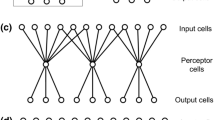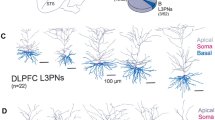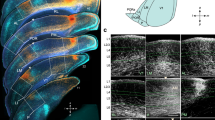Abstract
This paper is a sequel to an earlier paper which proposed an active role for the thalamus, integrating multiple hypotheses formed in the cortex via the thalamo-cortical loop. In this paper, I put forward a hypothesis on the role of the reciprocal, topographic pathways between two cortical areas, one often a ‘higher’ area dealing with more abstract information about the world, the other ‘lower’, dealing with more concrete data. The higher area attempts to fit its abstractions to the data it receives from lower areas by sending back to them from its deep pyramidal cells a template reconstruction best fitting the lower level view. The lower area attempts to reconcile the reconstruction of its view that it receives from higher areas with what it knows, sending back from its superficial pyramidal cells the features in its data which are not predicted by the higher area. The whole calculation is done with all areas working simultaneously, but with order imposed by synchronous activity in the various top-down, bottom-up loops. Evidence for this theory is reviewed and experimental tests are proposed. A third part of this paper will deal with extensions of these ideas to the frontal lobe.
Similar content being viewed by others
References
Brodal A (1981) Neurological anatomy. Oxford University Press, Oxford
Carpenter G, Grossberg S (1987) A massively parallel architecture for a self-organizing neural pattern recognition machine. Comp Vision Graphics Image Proc 37:54–115
Cavanagh P (1991) What's up in top-down processing. In: Gorei A (ed) Representations of vision. Camb. University Press, Cambridge, pp 295–304
Crick F, Knock C (1990) Towards a neurobiological theory of consciousness. Semin Neurosci (in press)
Deacon T (1988) Holism and associationism in neurophyschology: an anatomical synthesis. In: Perecman E (ed) Integrating theory and practice in clinical neuropsychology. Erlbaum, Hillsdale NJ
Deacon T (in preparation) Laminar organization of frontal corticocortical connections in the monkey brain
DeFelipe J, Jones E (1988) Cajal on the cerebral cortex. Oxford University Press, Oxford
Desimone R (1991) Face selective cells in the temporal cortex of monkeys. J Cogn Neurosci 3:1–8
DeValois KK, DeValois R, Yund EW (1979) Responses of striate cortex cells to grating and checkerboard patterns. J Physiol (London) 291:483–505
Dobbins A, Zucker S, Cynader M (1987) Endstopping in the visual cortex: a neural substrate for calculating curvature. Nature 329:96–103
Felleman DJ, Van Essen DC (1991) Distributed hierarchical processing in primate cerebral cortex. Cerebral Cortex 1:1–47
Fischler M, Elschlager RA (1973) The representation and matching of pictorial structures. IEEE Trans Comp 22:67–92
Fodor J, Pylyshin X (1988) Connectionism and cognitive architecture. Cognition 28:3–71
Freeman W, Skarda CA (1985) Spatial EEG patterns, non-linear dynamics and perception. Brain Res Rev 10:147–175
Gray C, Singer W (1989) Stimulus-specific neuronal oscillations in orientation columns of cat visual cortex. Proc Natl Acad Sci 86:1698–1702
Huber P (1981) Robust statistics. Wiley, New York
Ito M (1984) The cerebellum and neural control. Raven Press, New York
Mamelak A, Hobson JA (1988) Dream bizarreness as the cognitive correlate of altered neuronal behavior in REM sleep. J Cogn Neurosci 1:201–222
Pavlidis T (1988) Image analysis. Ann Rev Comput Sci 3:121–146
Pearson RCA, Brodal P, Gatter KC, Powell TPS (1982) The organization of the connections between the cortex and the claustrum in the monkey. Brain Res 234:435–441
Perkel DJ, Bullier J, Kennedy H (1986) Topography of the afferent connectivity of area 17 in the Macaque monkey. J Comp Neurol 253:374–402
Poggio T (1990) A theory of how the brain might work. In: The Brain. Proc Cold Spring Harbor Symp 55
Poggio T, Girosi F (1990) A theory of networks for learning. Science 247:978–982
Primrose D, Strick P (1985) The organization of interconnections between the premotor areas of the primate frontal lobe and the arm area of the primary motor cortex. Soc Neurosci (abstr) 11:1274
Rock I (1984) Perception. Sci. Am. Books, New York
Rockland KR, Virga A (1989) Terminal arbors of individual ‘feed-back’ axons projecting from area V2 to VI in the macaque monkey. J Comp Neurol 285:54–72
Rolls ET (1990) The representation of information in the temporal lobe visual cortical arteas of macaques. In: Eckmiller R (ed) Advanced neural computers, Elsevier, New York Amsterdam pp 69–78
Shepard R, Cooper LA (1982) Mental images and their transformations. MIT Press, Lancaster
Van Essen DC, Newsome WT, Maunsell JHR, Bixby JL (1986) The projections from striate cortex to areas V2 and V3 in the Macaque monkey. J Comp Neurol 244:451–480
Winfield DA, Gatter KC, Powell TPS (1990) An electron microscopic study of the types and proportions of neurons in the cortex of the motor and visual areas of the cat and rat. Brain 103:245–258
Yuille A (1991) Deformable templates for face recognition. J Cogn Neurosci 3:59–70
Author information
Authors and Affiliations
Rights and permissions
About this article
Cite this article
Mumford, D. On the computational architecture of the neocortex. Biol. Cybern. 66, 241–251 (1992). https://doi.org/10.1007/BF00198477
Received:
Accepted:
Issue Date:
DOI: https://doi.org/10.1007/BF00198477




